Looking to create a thriving underwater world within the confines of limited space? In this article, I’ll share my journey of navigating the challenges of selecting small yet vibrant saltwater fish for nano tanks. I’ve curated a list of 22 small saltwater aquarium fish that are perfect for your impressive nano tank. Join me as I unravel the unique characteristics and care tips for each of these miniature marvels!

There was this one time when space constraints became the reason I opted out of a large marine fish tank and instead went for a tiny one. That said, finding a small yet peaceful saltwater fish to keep in my nano aquarium was not at all easy.
I managed to find fish species famous for being among the smallest ones in the trade, but they were not really suitable for beginners to the hobby.
In fact, it was even more of a challenge to uncover ones that were also nano reef-safe and yet remained under 3 inches of body length.
Luckily for you, I’ve already spent hours researching what nano saltwater fish would be best for a small tank. I found quite a few cool entries, so you may want to bookmark this article for further references.
22 Small Saltwater Aquarium Fish for an Impressive Nano Tank
During my research for small saltwater fish, I stuck to the commonly accepted rule that a nano saltwater aquarium may be any tank that has a volume capacity of between 5 and 30 US gallons of water. For this reason, I made sure to keep a record of nano aquarium fish that remain under 3.5 inches of full body length.
To stock a nano aquarium you can try these 22 small saltwater fish:
1. Gumdrop Coral Croucher – Caracanthus madagascariensis

| Maximum Adult size: | 2 inches (5 cm) |
| Suggested tank size: | 15 gallons |
| Predominant Personality: | Peaceful and somewhat withdrawn. Not a typical display fish. |
| Suggested Companions: | Clown Gobies, Trimma Gobies, Coral Crouchers in 30-gallon tanks, Eviota, larger non-aggressive fish are also suitable. |
At 2 inches of full-grown body length, the Gumdrop Coral Croucher fish is a small reef fish that can squeeze through crevices, aided by its even tinier pectoral fins. These nano reef fish are more at home in a 15 to 30-gallon reef aquarium with adequate amounts of live rock and branching Small Polyp Stony corals (SPS).
The Gumdrop Coral Crouchers are members of the Caracanthus genus.
Anyway, the Gumdrop Croucher prefers to withdraw to the lonely sections of the tank like the crevices or caves.
It may be out of sight for days, not hiding from anyone but rather enjoying time alone.
That’s where a feeding tool such as a syringe or tweezers comes in handy.
Anyway, in my observations, the Gumdrop Coral Croucher is one of the most peaceful inhabitants any seasoned hobbyist could wish for in a nano saltwater tank.
However, in rare cases, it can harass males of its own kind, so it is best to keep a single male or a pair if the nano reef tank size allows it.
This small saltwater fish species may be small, but it belongs to the Scorpaeniformes. Therefore, as a relative to the scorpionfish, it has venom in its short spines.
Fortunately, the toxin is purely a defense mechanism used only as a last resort and under extreme provocation.
So just handle it with care, which is to say do not over-squeeze the fish.
I am yet to hear a report of other saltwater aquarium fish getting hurt by a Gumdrop Coral Croucher, as they will usually stay away from it.
Feed your Gumdrop Coral Croucher fish on Mysis and brine shrimp or other frozen foods.
A nano aqurium of 10 to 15 gallons is appropriate as a minimum living space for these small marine fish, but a 30-gallon one is better.
Need guidance on heater wattage? See more details in this comprehensive aquarium heater size post.
I recommend this nano tank equipment for a Gumdrop Coral Croucher:
- For the heater: You could use either the Cobalt Aquatics Neo Therm (check it out on Amazon.com) or the EHEIM Jager (check it out here) as they are both quality heaters that can be adjusted to fit the Coral Croucher’s temperature needs.
- I recommend using this inexpensive feeding syringe or a similar one as it has done well by me so far. Just cut a wider opening in the front so that it can suck larger pieces of food
- For the food: I recommend a mix of Mysis Shrimp and Brine shrimp (links point to Amazon.com), which you can blend or crush and rehydrate with old aquarium water
- For growing SPS corals I recommend LED lighting: The link on the left leads to my guide on that but for a tank that’s between 16 and 18 inches in height you can just get the AI Prime 16 HD or the Current USA Orbit Marine IC LED
- For making sure that your SPS corals will take off (optional): You can use some of the top-rated SPS coral foods such as PolyLab’s Reef Roids
2. Green Banded Goby – Tigrigobius multifasciatus

| Maximum Adult size: | 2 inches (5 cm) |
| Suggested tank size: | 10 gallons or more |
| Predominant Personality: | Peaceful and timid. |
| Suggested Companions: | Equally small and peaceful saltwater fish. |
Despite its small size, the Green Banded Goby from the Tigrigobius genus is a cute saltwater fish that’s hard to go unnoticed.
This small reef fish has an emerald body that’s separated into columns by mesmerizing bright stripes.
Its striking visual appearance is further enhanced by a yellow head that’s marked by a red stripe.
Unfortunately, Green Banded Gobies can be elusive creatures, so you won’t always have a chance to feast your eyes on their beauty.
In terms of personality, Green Banded Gobies are quite peaceful which makes them ideal tank mates for other equally calm nano fish.
Tailspot blennies and Pygmy Coral Crouchers are some of the most notable examples.
Despite their peacefulness, these small saltwater fish can get into scuffles among each other when they’re kept in larger groups. Due to this, I don’t advise keeping more than a pair in a 10 gallon nano tank.
Interestingly enough, Green Banded Gobies are protogynous hermaphrodites. Upon birth, all specimens are females but when they pair the bigger goby becomes male.
The only thing I dislike about these nano saltwater fish is their short life span.
Most green banded gobies live for no more than a year.
And by the time you buy them from the pet store, they’re already past their prime.
When it comes to diet, these small reef fish like to eat a variety of table shrimp, mysis shrimp and brine shrimp.
See more on choosing the perfect clownfish type in this comprehensive article.
3. Flaming Prawn Goby Fish – Discordipinna griessingeri

| Maximum Adult size: | 1 inch or 2.54 cm. |
| Suggested tank size: | At least 5 gallons. |
| Predominant Personality: | Peaceful and less shy with time. |
| Suggested Companions: | Non-aggressive gobies, shrimp, and other flaming prawn gobies. |
The Flaming Prawn Goby is a cool saltwater fish that is also small and docile enough for a pico reef tank. It is, therefore, possibly one of the best and most colorful fish species you could get for your 5-gallon aquarium.
This cryptic fish comes from the Discordipinna genus of gobies.
The Flaming Prawn Goby reaches a maximum adult size of 1 inch (2.54 cm), which makes it one of the very few saltwater fish suitable for a small 5-gallon nano tank.
It likes hiding (more so among live rocks or on a sandy substrate), perhaps fearing that its small size makes it easy prey.
Though the Flaming Prawn Goby is reef-safe, putting it in a relatively large aquarium with reef corals may be a sure way to never really see it again.
A friend of mine did just that, and he would only catch a glimpse of this small saltwater fish every couple of months.
For this reason, I recommend keeping the Flaming Prawn Goby in a small fish tank.
This way you may be able to enjoy its stunning beauty more often.
The way this marine fish looks is absolutely impressive, with its pointed dorsal fins and the red patterns on its tail fins standing out.
Bear in mind that this nano fish jumps out at times, so keep the aquarium under a lid.
Though among the smallest, The Flaming Prawn Goby is rather pricey due to high demand versus low supply.
So if you are like me and have a taste for rare gems, go for this unique fish.
This goby enjoys feeding on small brine shrimp, zooplankton such as copepods, and other meaty micro foods.
It will usually scavenge the sand bed for its food.
I recommend this aquarium equipment for keeping a Flaming Prawn Goby:
- I would use the Cobalt Aquatics Neo-Therm heater as it’s adjustable and small enough to fit in a 5-gallon tank
- To grow corals in such a small confined space I can recommend getting a Kessil A80 or the ABI Tuna Blue 12 Watt bulb if you’re on a tighter budget (click the links to see them both on Amazon)
4. Tailspot Blenny – Ecsenius stigmatura

| Maximum Adult size: | 2.5 inches or 6.3 cm |
| Suggested tank size: | At least 10 gallons. |
| Predominant Personality: | Will likely avoid conflict and mind its own business. |
| Suggested Companions: | Yellow tangs, gobies and other non-aggressive community reef fish. |
The large-eyed Tailspot Blenny belongs to the very numerous Ecsenius genus.
The Tailspot Blennies grow to a maximum size of 2.5 inches or 6.3 centimeters, from head to tail. In my experience, this rather small fish is peaceful and easy to care for, which makes it an excellent choice for a beginner. A 10-gallon aquarium will provide sufficient space for this fish.
I’ve also found another advantage of keeping one: if you want an algae-eating fish for your marine nano tank, give the Tailspot Blenny a try. This fish especially enjoys eating the algae on the live rock.
Essentially Tailspot Blennies are as good as Lawnmower Blennies at taking care of hair algae problems in a reef tank but are not as aggressive.
This, in combination with their small size of 2.5 inches makes them an excellent algae eater for a nano tank with reef corals.
I should also point out that the Tailspot Blenny along with most other Blennies and Gobies in general, are more resistant to parasites such as saltwater Ich because these fish have a thick slime coat. Though there are tested treatments for marine Ich that work, it can be a lot of hard work to eradicate.
Marine Ich is even more difficult to get rid of with a treatment that’s safe for display tanks, so a Tailspot Blenny can save you a lot of headaches in the long run. Anyway, I would recommend that the aquarium of your Tailspot Blenny has plenty of live rocks for them to perch on or hide in if need be.
They prefer the tank’s bottom and the crevices as their hangout spots.
The Tailspot Blenny is another peaceful fish that will not harass the other tank-mates in your saltwater aquarium.
House it with other equally friendly nano fish.
For a Tailspot Blenny I would recommend the following aquarium setup:
- As with most other nano tanks, I would recommend to set up a Neo-Therm heater, which can be adjusted to match the temperature required for a thriving Tailspot Blenny
- Make sure you have enough live rock for the Tailspot Blenny to hide in
5. Captive-Bred Orchid Dottyback Fish – Pseudochromis fridmani

| Maximum Adult size: | 3 inches (7.62 centimeters) |
| Suggested tank size: | Between 25 and 30 gallons for a single specimen. |
| Predominant Personality: | Semi-aggressive with captive-bred ones being more peaceful. |
| Suggested Companions: | Large angel tangs when in larger tanks, smaller clownfish, banggai cardinals, large damsel and hawkfish, most gobies. |
The Orchid Dottyback is a reef-safe fish species that grows to a maximum of 3 inches (roughly 7.6 cm). This purple nano fish is one of the best options to add extra color to your small saltwater reef aquarium.
This magnificent fish is assigned to the Pseudochromis genus.
I would say that its beauty is further enhanced by the two black lines that run from the nose tip up through the eyes.
Note that the fish is active and so a single specimen is most comfortable in a 25 to 30-gallon tank as a minimum.
According to my research, Orchid Dottybacks may need to be captive-bred in order to be more tame and manageable in terms of temperament.
The captive-bred ones will likely be shyer, especially when acclimating.
Thus, provide these small saltwater fish with enough hiding places such as established coral reefs or a good amount of live rock in your aquarium.
However, I would not go as far as saying that they are entirely docile; the Orchid Dottyback is semi-peaceful and may, at times, chase the smaller fish in the tank.
If you keep two, they will fight over their perceived territory until one ends up killed.
If you really want to keep more than one Orchid Dottyback in the same aquarium, you may add them to the tank at the same time so that they learn to tolerate each other.
From what I found, it seems likely that having more live rocks also helps to alleviate aggression.
The Orchid Dottybacks will eat Krill shrimp, bristle worms, and other frozen aquarium foods for carnivores.
6. Pygmy Coral Croucher – Caracanthus unipinna

| Maximum Adult size: | 1.5 inches or 3.8 cm |
| Suggested tank size: | 10 gallons. |
| Predominant Personality: | A loner who’s confident and not scared of larger tank mates. |
| Suggested Companions: | Equally peaceful fish, like the Chromis varieties, but can basically be housed with anything that is not super aggressive and the size of the tank mates does not seem to matter. |
Measuring a paltry 1.5 inches (3.8 cm), the Pygmy Coral Croucher is a small reef fish that suits a saltwater nano tank with lots of SPS corals. A 10-gallon reef tank with enough live rock will make an adequate home for a single specimen.
This species within the Caracanthus genus loves to spend its time perching among the branching corals.
From my observations, the Pygmy Coral Croucher rarely comes out in the open.
For this reason, in a coral reef aquarium, this little fish may get out of sight for, sometimes, days.
It is peaceful and shy but I would not recommend it for a beginner because it may need special care like target-feeding.
Upon some further research, I found that the sting from a Croucher rarely feels stronger than a bee’s sting.
Remember that keeping this fish in a nano aquarium is actually recommended if you want to see it from time to time.
7. Banggai Cardinalfish – Pterapogon kauderni

| Maximum Adult size: | 2.7 inches (around 7 cm), but rarely a specimen may reach 3 inches or 7.6 cm. |
| Suggested tank size: | At least 30 gallons. |
| Predominant Personality: | Semi-aggressive, if the fish feels there’s not enough space to retreat to. In a good environment, they will remain calm and docile. |
| Suggested Companions: | Clownfish, Blennies, Butterflyfish, Boxfish, Firefish, Gobies. |
An adult Banggai Cardinalfish grows to a maximum of 2.7 inches or slightly less than 7 centimeters. An aquarium of 30 gallons is ideal for these small saltwater fish because they love to swim and therefore a rather spacious nano tank comes in handy.
Coming from the Pterapogon genus, the Banggai Cardinalfish is a cool-looking fish with black spots and a forked caudal fin.
From my experience, they hide from predators or other imaginary threats and therefore require rock caves and crevices to hide in.
The temperament of this fish is, in my opinion, controversial at the least.
I would classify the ones I’ve kept as rather peaceful because they enjoyed living and interacting with other members of the aquarium.
However, during my research, I’ve found that occasionally the Banggai Cardinalfish may turn aggressive against its own species when it comes to claiming or marking territories.
What I found works best in such scenarios is having more caves in the aquarium. Other than that this is a truly reef safe fish and its main day-to-day activity seems to be calmly patrolling the middle water column.
What’s important to remember is that you should feed the fish on meaty foods such as bloodworms but not dry or prepared foods like flakes or pellets.
8. Gold Assessor Basslet Fish – Assessor flavissimus

| Maximum Adult size: | 3 inches or 7.6 cm. |
| Suggested tank size: | At least 30 gallons for a single specimen. |
| Predominant Personality: | Semi-aggressive towards its kind but very peaceful towards other tank mates. Needs a well-thought nano tank with a lot of hiding places to feel comfortable, so it may not be suitable for beginner aquarists. |
| Suggested Companions: | Anything but big, aggressive fish. |
The Gold Assessor Basslet measures almost 3 inches when fully grown. Therefore this saltwater fish may be kept in a small tank of 30-gallons.
This predominantly yellow fish from the Assessor genus feels most at home in a reef aquarium with corals and rock landscape.
My experience has been that Gold Assessor Basslets have a rather timid temperament and hence it takes them days or weeks to get used to their new fish tank.
If you keep more than one Goldfish Assessor Basslet, expect fights over territories, especially if the aquarium has fewer rocks or corals.
However, they won’t harass other tank-mates or even invertebrates.
I would recommend that you only get one specimen per nano reef tank as 2 specimens would need more than 30 gallons to get along.
This small fish is big on price these days, as it is somewhat hard to come by.
However, I believe that it is nevertheless a wonderful addition to any saltwater aquarium.
9. Panamic Barnacle Blenny Fish – Acanthemblemaria hancocki

| Maximum Adult size: | 1.8 inches or around 4.5 cm. |
| Suggested tank size: | 5 to 10 gallons, preferably the latter. |
| Predominant Personality: | Docile, until they start dashing around when it’s feeding time. VERY entertaining overall. |
| Suggested Companions: | Clown Goby, Dartfish And Cardinal Fish, Seahorses in pico reefs, Clownfish, Chromis. |
The Panamic Barnacle Blenny Fish measures 1.8 inches or around 4.5 centimeters and is green or white with red spots, while its dorsal fins, lips, and iris are red. This super colorful fish is peaceful all year round and is a perfect addition to a small saltwater aquarium.
The Panamic Barnacle Blenny Fish is part of the Acanthemblemaria genus.
I find these predatory fish to be lively, super-fast, and entertaining to watch as they dash at lightning speed to grab food at mealtimes, after surveying the area.
Once a Panamic Barnacle Blenny has the food, it usually hurries back as fast.
One thing they never do is sit back at meal times while the rest eat.
But it is best you ensure they get their fair share of food (read target or spot feeding) if the competition is too much for them.
In fact, I’ve found target feeding to be key for successfully keeping these small fish.
I recommend feeding your Barnacle Blenny multiple times a day if possible.
I would say that they are otherwise easy to take care of, and if you’re a beginner who’s not afraid of a little more work you will likely pull it off.
This micro fish enjoys finely-chopped meaty foods such as frozen brine or Mysis shrimp. In my experience, a 10-gallon reef aquarium would be fine for these cool fish, provided it has plenty of rocks with crevices to act as potential hideouts.
Panamic Barnacle Blennies are one of my favorite nano marine fish for a single-species aquarium.
Things could get really entertaining when it’s feeding time.
Recommended Read for Later: Best Fish for a 5-Gallon Saltwater Aquarium
10. Twin Spot Goby – Signigobius biocellatus
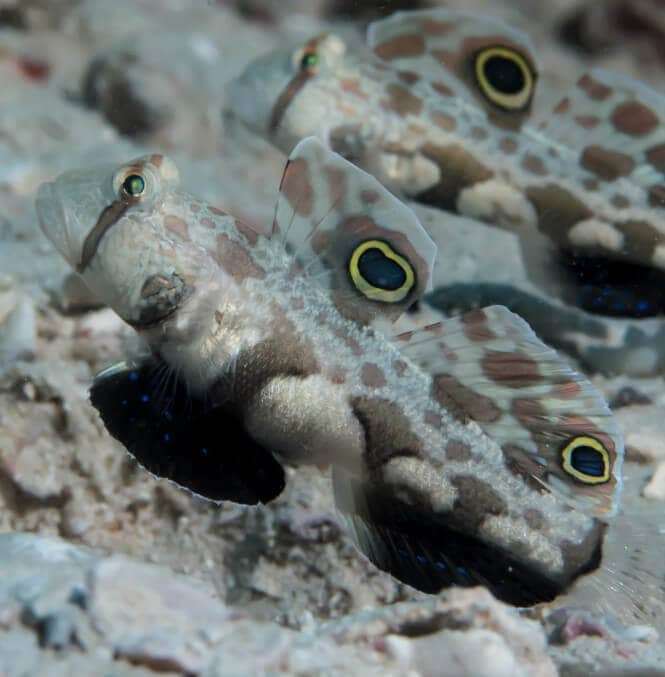
| Maximum Adult size: | 3.5 inches or 8.9 cm. |
| Suggested tank size: | At least 10 gallons. |
| Predominant Personality: | Peaceful and timid bottom dwellers that may fight their own kind for territories. |
| Suggested Companions: | Better kept in a species only if it’s a nano tank but – Sharknose, Tailspot Blenny, Yellow Watchman Goby, Green Clown Goby, peaceful nano Gobies in general, NO aggressive feeders |
The Twin Spot Goby A.K.A. The Two Spot Goby is another stunning nano fish that can suit a reasonably small saltwater aquarium.
It grows to a maximum of 3.5 inches in length (nearly 9 cm).
This fish species from a genus known as Signigobius is white all over with splashes of orange markings.
Such-colored fish typically have an overall remarkable appearance in the aquarium.
Anyhow, the Twin Spot Goby is a sand sifting goby species and will always be seen scooping and processing fine substrate particles through its gills. Following these thoughts, if you want to keep this fish I’d recommend having an established, mature sandbed.
Otherwise, the sand in your tank may not have the right self-sustainable microfauna for them, and the Twin Spot Goby can end up skinny.
This also means that these fish are not easy to feed because they will generally refuse the prepared food you offer.
To avert such a scenario, you need to squirt some live or frozen, vitamin-enriched foods into the sand.
Their microfauna diet can be supplemented with Mysis shrimp, micro worms, etc.
Just make sure the food is extra small and the currents slower so that the Twin Spot Goby can eat comfortably.
Needless to say, the Twin Spot Goby needs intensive care, especially in the acclimation period.
Microfauna in aged sand is the best food source for the Twin Spot Goby. Therefore, the Twin Spot Goby is not a saltwater fish I’d recommend to a beginner looking to stock a nano tank.
While they are exciting to watch as a pair, they can only live peacefully together if they were simultaneously introduced into the tank to bond from the start.
If a second Two Spot Goby is added later, the fish would likely fight over territory.
These small Goby fish are, however, generally peaceful as they never bother with other tank-mates.
A 10-gallon fish tank will likely be enough, as long as it has a sandy substrate with a large enough population of micro worms.
11. Court Jester Goby – Koumansetta rainfordi

| Maximum Adult size: | 2.8 inches or 7.1 cm. |
| Suggested tank size: | 10 gallons, preferably established. |
| Predominant Personality: | Super peaceful. |
| Suggested Companions: | Equally peaceful tank-mates. |
Also known as Rainford’s Goby, the Court Jester Goby fish measures a maximum of 2.8 inches or 7.1 centimeters in its adulthood. With its small body size and calm temperament, the Court Jester Goby becomes a great addition to a nano saltwater tank.
The brightly-colored Court Jester Goby belongs to the small Koumansetta genus.
Anyhow, as with most non-aggressive micro gobies, it may be best if the aquarium has a decent amount of live rocks and sand on which this small fish can spend time grazing.
The Court Jester Goby is an algae-eating nano fish and likes the lower levels of a marine reef tank.
The rocks should have hiding places too because in my experience the fish can be really timid and shy.
The CS Goby is usually really peaceful yet active as long there are no aggressive tank-mates around.
You may often spot it somewhere alone nibbling on softer hair algae or sifting through the sand.
Some users report this fish doing better in reef tanks with finer sand beds.
What’s important to remember about the Court Jester Goby is that you will rarely see it eat.
With a well-established microfauna in the sandbed, however, it will take care of its own.
These fish are technically omnivores and you should not get one just for the sake of eating algae in the reef aquarium.
Court Jester Gobies are somewhat finicky eaters and I would never recommend getting one to someone who’s just starting out with saltwater fish keeping.
I have seen these fish eat frozen or live Mysis and brine shrimp, so keep that in mind if you think yours is getting skinnier.
Nonetheless, this nano fish species is super colorful and has its own interesting personality.
A 10-gallon reef tank can be enough for this cool fish.
Get one only if you like a challenge and are after a small saltwater fish that loves to eat from time to time.
12. Longspine Cardinalfish – Zoramia leptacantha

| Maximum Adult size: | 2.5 inches or 6.3 cm. |
| Suggested tank size: | 20 gallons for a small school of 3, but you can keep a large school in big reef tanks. |
| Predominant Personality: | May be aggressive towards one another until they establish a pecking order, but after that, they will calm down and do their thing. |
| Suggested Companions: | Peaceful dartfish, firefish, clownfish, wrasses, gobies, and so on. |
Measuring about 2.5 inches as an adult, the Longspine Cardinalfish is a small saltwater schooling fish that you can keep in a nano aquarium. In fact, you can keep them in both small and large tanks as long as there are no aggressive tank mates to bother them.
This semi-transparent fish is a member of the Zoramia genus.
While each Longspine Cardinalfish does not have much color to it, they make an impressive lot when in a group.
In my observations, they are relatively slow, and rather methodical swimmers.
The bare tank size for 1 specimen is 10 US gallons, but you can put 3 or 4 in a 40 gallon one, as the bioload of these saltwater fish is relatively small.
There may be some aggression among their own at first in order to establish a pecking order.
When you keep them in a sizable group in larger reef aquariums, Longspine Cardinalfish soon form a hierarchy that is strictly observed as they shoal together.
In my experience, they are also non-aggressive and will likely avoid conflicts with other tank-mates in the system.
However, they are predatory fish and may prey on smaller micro fish in your saltwater tank, so do keep this in mind if you want to keep other nano fish in the same tank.
The general rule is that the other fish should not fit in the Cardinalfish’s mouth.
Longspine Cardinalfish get timid if they are fewer in numbers and will retreat behind the live rock, or coral reefs if they feel insecure.
They also will feed reluctantly and prefer not to swim in the open during the daytime unless you keep them in a large school.
A tank of 20 gallons is enough if you are keeping 2-3 of them.
13. Flametail Blenny Fish – Enchelyurus flavipe

| Maximum Adult size: | 3.5 inches (8.9 cm). |
| Suggested tank size: | 30 gallons. |
| Predominant Personality: | Depends on the individual, can be both calm or somewhat aggressive to other similarly-shaped nano reef fish. |
| Suggested Companions: | Be cautious with other small blennies, and gobies, but larger reef fish with peaceful temperaments are suitable. |
The Flametail Blenny is a beautifully colored fish that grows up to a maximum of 3.5 inches and is also reef-compatible. Its size, colors, and reef compatibility makes it an excellent addition to a nano tank with a water capacity of 30 gallons.
The stunning Flametail Blenny comes from the Enchelyurus genus.
During my research on these blennies, I’ve found that they love to eat and never let a morsel go to waste.
They would mainly hang out at the aquarium’s bottom near the rocks, seeking food from one crevice to the other.
The Flametail Blenny is an omnivore but will enjoy feeding on algae, so get it if you need a small saltwater fish that can eat the algae regularly.
Provide live rocks with microalgae to keep them busy.
Supplement their algae diet with Mysis or brine shrimp.
Flametail Blennies are neither peaceful nor aggressive and the temperament of yours totally depends on its personality.
Most of them will keep their cool and do nothing but scavenge for food when they get comfortable in their new tank.
On occasion, however, they may turn aggressive against dartfish or gobies over territories if the fish tank is too small.
For that reason, I would say that a 30-gallon community aquarium is suitable for these small and lively saltwater fish.
Note that the Flametail Blenny fish is a high-jumper so you should likely have the lid on your reef tank tight.
14. Mini Dart Goby Fish – Aioliops megastigma
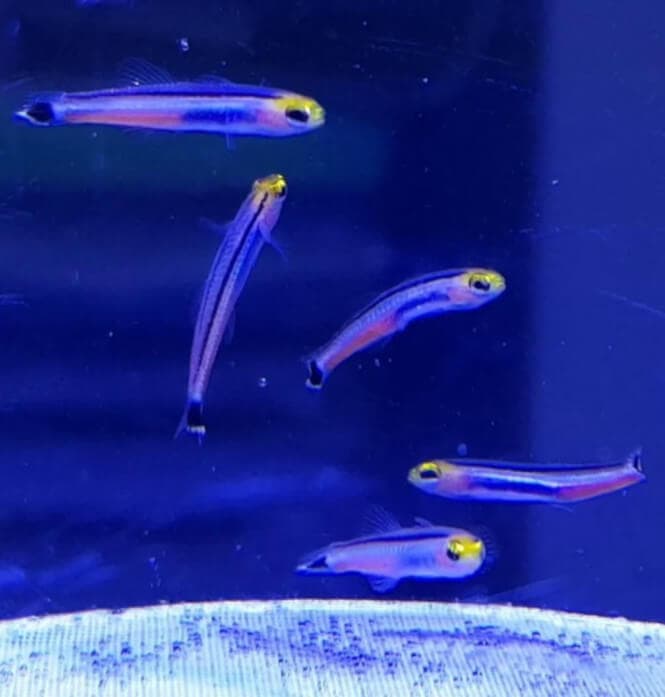
| Maximum Adult size: | 1 inch or around 2.5 cm. |
| Suggested tank size: | 5 to 10 gallons for a couple of specimens. |
| Predominant Personality: | Active swimmers that won’t bother anyone else in their aquarium. |
| Suggested Companions: | Just avoid the more aggressive marine fish. |
The maximum grown-up size of a Mini Dart Goby fish is just about 1 inch, which makes them an appealing choice for a small tank.
The Mini Dart Goby Fish are among the members of the Aioliops genus of dartfish.
These fish are among the cutest and enjoy sticking together because they really love one another.
Mini Dart Gobies don’t fight among themselves when in a group.
These small, and cool-looking fish will peacefully shoal in the midsection of your saltwater reef aquarium, troubling no tank-mates.
A fish tank of 5 to 10 gallons will be comfortable for a small school of 3-5 specimens as their bioload is relatively unnoticeable in a closed system.
Before you rush to a place that sells live saltwater fish online (or your LFS), I should point out that though they seem to perfectly fit a peaceful nano aquarium, Mini Dart Gobies are not really beginner-friendly. They may become very picky about their foods and on top of that, not many things fit their small mouths.
Mini Dart Gobies need to be fed multiple times a day and the most success I’ve had was with baby brine shrimp and live copepods.
Another thing I should point out about these micro fish is that their life span is relatively short – 1.5 years with extremely diligent care.
For that reason, I consider the Mini Dart Goby to be a nano reef fish that requires expert-level care.
15. Firefish Goby – Nemateleotris magnifica
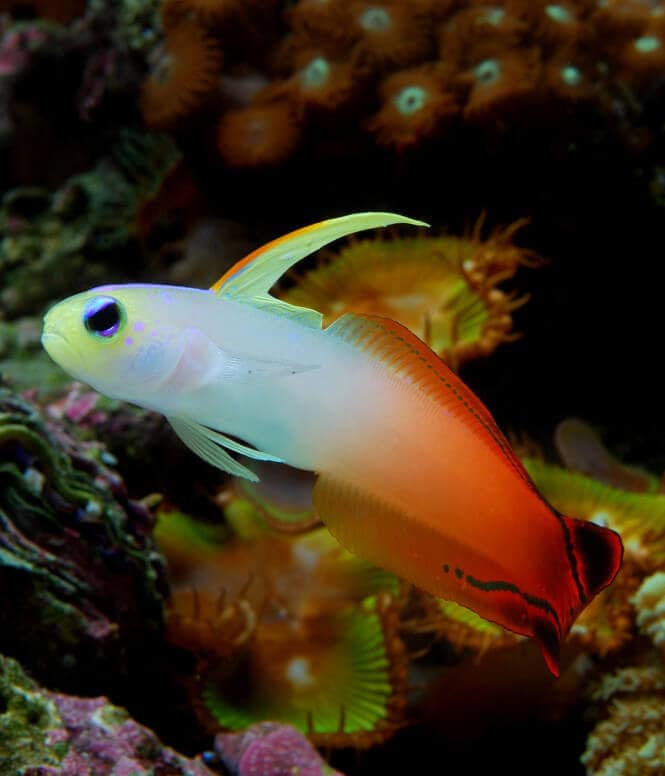
| Maximum Adult size: | 3 inches (7.6 cm). |
| Suggested tank size: | 20 gallons/pair. |
| Predominant Personality: | Peaceful towards others, but can get aggressive among each other. |
| Suggested Companions: | More passive clownfish, Shrimp Gobies, Possum wrasses, Watchman gobies, peaceful cardinalfish, reclusive anthias, non-paired pajama cardinalfish, tailspot blennies. |
The handsome Firefish Goby is a species within the Nemateleotris genus.
This yellow saltwater fish measures 3 inches when fully grown and is rather timid.
The reef aquarium, the Firefish Goby is kept in, may need to have handy hideouts into which the fish can quickly bolt when startled.
Therefore create rocky caves for it, or else it would jump out of the tank when scared or stressed if there’s an open lid.
However, like some other fish from this genus, this slender saltwater fish is not afraid to confront and fight family members, though this may only happen if they are crowded in a very small tank.
Otherwise, even with this shortcoming, the Firefish Goby is still, in my opinion, one of the best nano reef fish a saltwater keeper can have in his tank. It will never bother or get in the way of other tank mates.
They love to swim in the middle section of the aquarium’s water column, once they judge the coast is clear. Bear in mind that this fish enjoys low water currents, so be mindful when choosing your reef powerheads.
The minimum fish tank capacity to successfully keep a pair of Firefish Gobies is 20 gallons.
16. Royal Gramma Fish – Gramma loreto
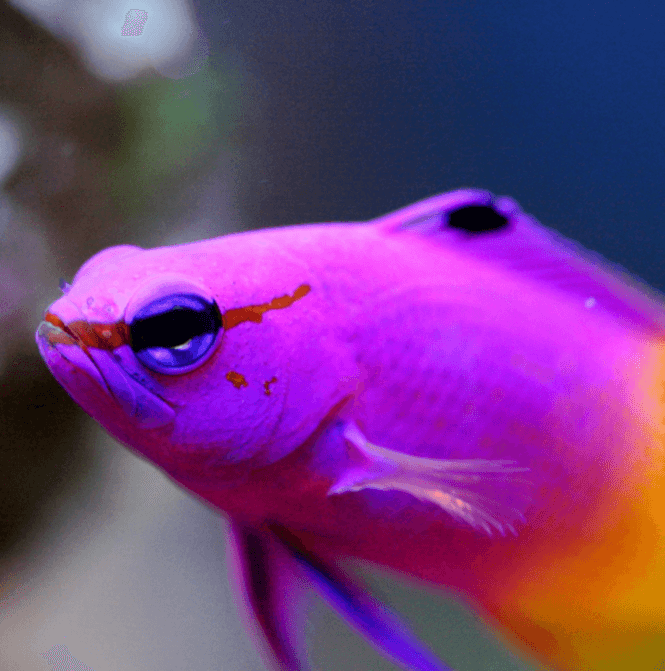
| Maximum Adult size: | 3.5 inches or almost 9 centimeters. |
| Suggested tank size: | 30 gallons with lots of caves and crevices. |
| Predominant Personality: | May become aggressive towards fish with similar appearance but is overall easy-going. |
| Suggested Companions: | Gobies, various Jawfish, Boxfish, Clownfish, Hawkfish, Firefish, Angelfish, rabbitfish. |
The Royal Gramma Fish is a reef-compatible nano fish that grows to up to 3 inches long, on average. You can safely keep a single Royal Gramma specimen in a small reef aquarium of 30 gallons, as long as there are no fish that resemble its body shape.
The amazingly-colored Royal Gramma Fish is a representative of the Gramma genus.
This small fish can get aggressive if its living space is occupied by fish who look similar, such as some blennies.
The Royal Gramma may end up relentlessly chasing the perceived competitor unless the saltwater aquarium provides sufficient chilling spots for both (caves, crevices, dense reef corals).
In my experience, the best approach to keeping a small Royal Gramma without incidents is to add last to the nano reef tank.
This way it will feel too new, which will reduce the “I own everything” behavior.
Once a Royal Gramma establishes a territory, a conqueror may first have to kill it to get the place.
Though I think the Royal Gramma is one of the coolest saltwater fish that remain small, I recommend exercising caution when planning a reef tank with them in mind.
Anyway, at times the Royal Gramma fish swim upside down, to look at life from a different perspective, as they navigate about the aquarium.
This behavior shouldn’t alarm you when it’s done close to a cave or other surface. However, if the fish does it out in the open it may be a sign of swim bladder issues.
The Royal Gramma is a hardy, reef-safe fish which means that it’s fairly easy to care for one.
Therefore The Royal Gramma is suitable for a beginner who’s setting up his or her first saltwater nano aquarium.
Of course, these small fish can be kept by beginners as long as the aquarist has done prior research on their behavior.
Feed your Royal Gramma fish on (preferably) Mysis and brine shrimp but know they are not a picky eater.
17. Ocellaris Clownfish – Amphiprion ocellaris

| Maximum Adult size: | 3.5 inches or 8.9 centimeters. |
| Suggested tank size: | 20 gallons. |
| Predominant Personality: | Semi-peaceful. |
| Suggested Companions: | Other Damselfish, Tangs when in large aquariums, Dartfish, Angelfish, Blennies, Anemones, Gold assessor fish, cardinalfish, chromis. |
An adult Ocellaris Clownfish may reach a maximum of 3 inches or nearly 8 centimeters in body length. Because of its size, this fish may be a good fit for a small nano tank, but caution should be exercised with its cohabitants, as the Ocellaris Clownfish can be semi-aggressive.
The well-known Ocellaris Clownfish is assigned to the Amphiprion genus of anemonefish.
Also, don’t let the small measurements of this fish deceive you. Clownfish have a life expectancy that is 6 times greater than other fish of their size.
Anyway, apart from their bright coloration, the fish is famous for seeking refuge in the clusters of stinging anemones.
However, my experience with them has been that you can keep one even without an anemone.
I’ve found that they are hardy, acclimate quickly, and are relatively easy to take care of.
The Ocellaris Clownfish readily eat many types of marine food and are safe for a reef aquarium system.
However, Clownfish are still a type of Damselfish, which are known for their aggressive behavior.
If you’re a beginner to saltwater tanks but want an Ocellaris as a centerpiece nano fish for yours I’d advise you to add the specimen last to the aquarium.
This way the fish won’t give new additions a bad time.
It’s also worth noting that the Ocellaris Clownfish is overall calm upon proper care and a balanced aquarium environment.
Peace can have its limit, however, so do not mix different clownfish varieties together if you want to maintain order. I would not add more than one or a pair, as this would be more than enough if I wanted to avoid incidents with the other nano fish.
I should note that the Ocellaris is not the smallest clownfish: The smallest Clownfish breed is the Percula clown, reaching no more than 2.6 inches in total body length. However, the Percula clownfish are considerably more aggressive than an Ocellaris and are not as hardy.
This is my main reason for excluding them from this list. Anyway, a 20-gallon reef tank is an excellent home for a pair or a single specimen of Ocellaris Clownfish.
18. Sharknose Goby – Gobiosoma evelynae

| Maximum Adult size: | 1.8 inches or 4.6 cm. |
| Suggested tank size: | 10 gallons as a bare minimum, preferably 15. |
| Predominant Personality: | Super peaceful and full of personality. A really active fish. |
| Suggested Companions: | Clownfish, Wrasses, Powder Brown, and other tangs in larger tanks, blennies, gobies, Comets, and generally any peaceful to semi-aggressive saltwater fish. |
A mature specimen of Sharknose Goby grows to about 1.8 inches. Such a size makes this reef fish small enough to be a reasonable candidate for a nano saltwater tank. Sharknose Gobies are extremely peaceful and would often clean other tank mates from parasites, a valuable role in a community aquarium.
These fabulous fish belong to the Gobiosoma genus.
I find watching these small fish thrilling as they are full of personality and the whole community starts acting uniquely around them.
The Sharknose Goby quickly becomes popular among its tank mates for ridding them of dead scales, and external parasites.
I’ve witnessed other fish literally lining up in front of the Sharknose’s cave to get cleaned.
The goby comes out, cleans its larger fish, and goes back, no questions asked.
It’s an interesting phenomenon you’d definitely like to watch.
I’ve found that you may add a Sharknose Goby to your reef tank purely as a parasite control agent.
In fact, if you stick your hand in the water, the fish will clean it too.
This striped fish is obviously peaceful and won’t chase or hurt other small fish.
I would recommend the Sharknose Goby to any nano reef enthusiast.
The only negative to this fish is its rather short lifespan of 1.5 years.
Anyway, supplement their parasite menu with frozen brine shrimp and live worms.
A saltwater fish tank of at least 15 gallons is accommodative enough for the Sharknose Goby.
19. Yellow-Striped Cardinalfish – Apogon cyanosoma

| Maximum Adult size: | 2.5 inches or 6.4 cm. |
| Suggested tank size: | at least 10 gallons. |
| Predominant Personality: | Really serene. |
| Suggested Companions: | Flasher Wrasse, Dartfish, Gobies, Blennies, and any other non-aggressive marine fish. |
Coming from the Apogon genus, the Yellow-Striped Cardinalfish is a slender, large-eyed fish that measures no more than 2.5 inches when mature.
There are 6 yellow stripes along the body of this saltwater nano fish.
The color pattern, along with a fake eye close to their tails, helps in maneuvering the predators at night.
The coloration makes it hard to tell which direction the fish moves next, especially when they’re in a group.
These slow swimmers create a strict hierarchy at first but it’s a common misconception that they will form schools.
The Yellow-Striped Cardinalfish rarely shoal; they do it when squeezed in a fish tank that’s too small.
No family squabbles whatsoever so you can keep a small group in your nano reef aquarium.
Nevertheless, you can keep a single specimen in a 10-gallon tank without issues.
These small beauties are also peaceful, hardy, and easy to keep.
I would definitely recommend them to a beginner who’s just starting out with small saltwater fish in a nano reef aquarium.
Feed the yellow-striped Cardinalfish frozen shrimp or bloodworm, though they’re not a picky eater and will likely eat any pellets as well.
20. Clown Goby Fish – Gobiodon okinawae

| Maximum Adult size: | 1.5 inches or 3.8 centimetres. |
| Suggested tank size: | 10 gallons. |
| Predominant Personality: | Peaceful but will pick on SPS corals and according to some reports even LPS would not be safe. |
| Suggested Companions: | Tangs in larger tanks, other Gobies, Ocellaris Clownfish, Comet fish, Cardinalfish, most Blennies, Assessors, and Anthias. |
The Clown Goby from the Gobiodon genus measures a mere 1.5 inches at most.
However, this fish still stands out in an aquarium due to its vibrant, uniform color, which is either yellow or green.
I especially like the cool-looking, Yellow Clown Goby.
Anyway, this well-built, sturdy fish enjoys perching on coral branching or live rocks or just swimming in the open where you can admire its attractive color.
A mated pair will live peacefully in a nano aquarium.
The fish is generally friendly to other tank-mates but is generally not reef-safe.
Though they do feel more at home in a reef fish tank a Clown Goby will most likely pick on colonies of stony corals with small polyps (SPS).
For this reason, I would not attempt to keep these nano fish if I wanted a small reef tank with SPS corals.
Anyway, you could still keep them in a simple saltwater tank with live rock and a sandbed.
The Clown Gobies need caves and crevices to cool off when stressed or exhausted.
Due to their small size, a 10-gallon nano tank is suitable for a couple of these small saltwater fish.
21. Falco Hawkfish – Cirrhitichthys falco

| Maximum Adult size: | 2.5 inches or 6.4 centimetres. |
| Suggested tank size: | 30 gallons to give other smaller fish room to hide. |
| Predominant Personality: | Relatively aggressive towards smaller fish and invertebrates, but won’t bother fish of the same size. |
| Suggested Companions: | Same-size or larger but peaceful tank-mates. |
A fully-grown Falco Hawkfish will measure roughly 2.5 inches in total body length. This saltwater nano fish is hardy and makes a fantastic candidate for a small tank with reef corals.
This cool saltwater fish is among the species in the Cirrhitichthys genus, and is absolutely full of personality.
It perches on rocks or corals, quietly watching and noting everything going on in and out of the aquarium.
The Falco Hawkfish is a keen observer, always the first one to see you approaching with food and the first to avail itself for it.
I won’t say the Falco Hawkfish is outright aggressive as some aquarists put it, but it may exhibit its predatory behavior by preying on smaller fish and invertebrates.
Because of this, I do not recommend housing it with the smallest of tank-mates.
During my research on this fish species, I’ve found that no invertebrates should be added after the Falco Hawkish because it will mistake them for food.
In fact, add shrimp prior to the Falco or with the lights off.
Either way, the Falco won’t be able to spot them easily.
Other tank mates should be at least 1.5 inches to not be treated as a potential meal.
Feed your small predatory Falco Hawkfish on marine meat, Mysis, and brine shrimp.
I find it fascinating to watch this nano fish grab a piece like a hawk, fly with it to some secluded spot and devour it before returning for another.
An aquarium with a volume capacity of 30 gallons and a lot of hiding places is necessary for a Falco Hawkfish to feel comfortable.
22. Randall’s Prawn Goby – Amblyeleotris randalli

| Maximum Adult size: | 3.5 inches (8.9 cm) |
| Suggested tank size: | 30 gallons |
| Predominant Personality: | Mostly peaceful, but might eat small ornamental shrimp or other small invertebrates |
| Suggested Companions: | Candy Cane Pistol shrimp or other members of the Alpheus genus |
Randall’s Prawn Goby (Amblyeleotris randalli) is one of the most remarkable gobies in the aquarium hobby.
Unlike most other gobies who are relatively withdrawn, Randall’s Prawn Goby has a symbiotic relationship with Candy Cane shrimp and other shrimp from the Alpheus genus.
Since these types of shrimp are mostly blind, they have to rely on the goby’s sight for threat detection and in return, they share their burrow.
Additionally, both of these aquatic creatures also aid each other when foraging for food.
Apart from being tight with shrimp, Randall’s Prawn Goby also gets along with other small and calm fish.
The only occasion in which these fish might act aggressively is when their territory gets threatened by other bottom dwelling fish.
Such acts, however, are extremely rare so you should be fine as long as you keep them with non aggressive fish.
Nano Fish Doesn’t Always Mean Peaceful Fish
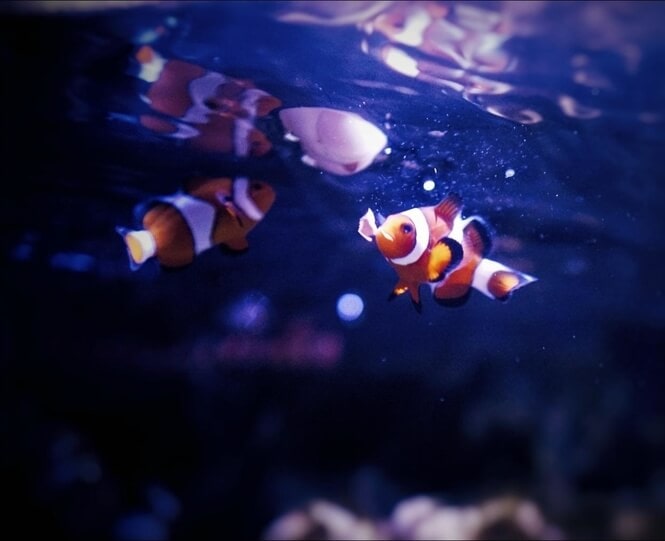
One should not assume that all nano fish are simply too small to be aggressive or a threat to other tank-mates.
When it comes to (mis)behavior, size matters in the least.
An otherwise peaceful fish’s temperament can be influenced by external factors like the species of its aquarium companions.
On the other hand, I’ve found that most dwarf Damselfish, for example, are usually described as peaceful but will actually drift towards aggressive behavior.
A good example of such nano fish is the Green Chromis.
This is not always the case, but I have personally observed enough horror stories involving these fish.
In fact, it’s why I did not include Chromis in the list above, notwithstanding its popularity.
It’s a good fish but from what I’ve experienced, it can be annoying to keep with peaceful tank-mates. The bottom line is: choose nano fish carefully and be absolutely sure the aquarium settings favor all of the tank’s inhabitants.
What Nano Pet Fish Should You Get For A Small Tank If You Are A Beginner?
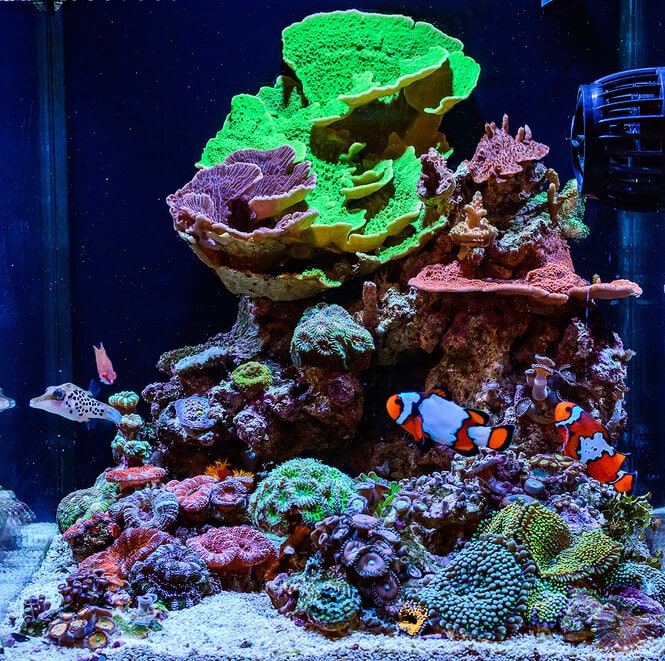
For beginners with small saltwater tanks, I recommend looking into the Tailspot Blenny, the Royal Gramma Fish, a single Ocellaris Clownfish, a Sharknose Goby, Yellow-Striped Cardinalfish, and Clown Goby Fish.
All of these fish are small, generally hardy, and non-aggressive, which makes them easy to look after if you’re a beginner. Nevertheless, do some research on whether the fish you chose is tropical and get your nano reef tank a small heater if needed.
The listed species will acclimate relatively quickly and eat a variety of foods, so any diet mistake by a beginner may not have adverse repercussions. A quick tip to beginners from my experience: get a beneficial bacteria supplement to cycle your nano fish tank faster.
My Personal Favorite

Choosing the best small saltwater fish out of such a wide variety certainly isn’t easy.
I believe each fish on this list stands out in its own way, be it with its extravagant looks or quirky character.
But if I have to pick a favorite, it would definitely be the firefish goby.
Firefish gobies may not be as flashy as the Flaming Prawn Goby or as exuberant as the Panamic Barnacle Blenny, but they’re affordable, easy to keep and interesting to watch.
What about you?
Which of these small fish seems the most appealing?

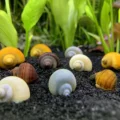



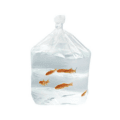




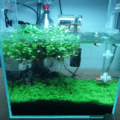
Wonderful job and a very good selection. I will quibble a little, though. I understand your concern re: damsels, they certainly van be/become aggressive, especially the black and white 3 or 4 striped ones. Dottybacks are also quite aggressive, so suspect. But the Purple Striped Dottyback is no more aggressive than the Orchid, and for my money is even more beautiful.
Absolutely great work. I can imagine you were sitting a while on this blog post. But very usefull and highly informative.
Thank you very much for your great work.
Thank you so much!
Great job on posting this great info for saltwater beginner. I found this to be the best guide to help me choose what fish to get and what to avoid for my 36 gallon fish tank.
Makes me happy that you liked it, Ted.